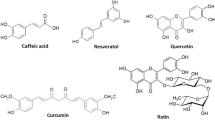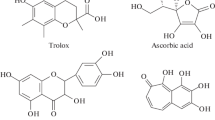Abstract—In this work, we compared the efficacy of quercetin, one of the best known and widely investigated flavonoids, and the inclusion complex of quercetin and hydroxypropyl−β-cyclodextrin in prevention of disturbances in redox balance of rat liver mitochondria and erythrocytes during oxidative stress and regulation of the process of the mitochondrial permeability transition pore formations in vitro and theoretically calculated the structure of quercetin and its oxidative forms, as well as their molecular electronic properties. Quercetin (5–100 μM) inhibited membrane lipid peroxidation and reduced glutathione oxidation dose dependently in both rat liver mitochondria and erythrocytes during exposure to tert-butyl hydroperoxide (700 μM). Simultaneously, quercetin (25 μM) stimulated the Ca2+-induced mitochondrial permeability transition pore formations and inhibited this process at higher concentrations (100 mM). The incorporation of quercetin in the supramolecular complex with hydroxypropyl−β-cyclodextrin enhanced its antioxidative activity, first of all, in the cytoplasm of the cell and mitochondrial matrix. Molecules of quercetin, semiquinone radicals, and stable products formed in the oxidation, ortho- and p-quinone methide, have a planar structure. The calculated value of the dipole moment of the quercetin molecule is 4.34 D. The quercetin molecule is thermodynamically more stable than the products of its oxidation, among which p-quinone methide-III is the most stable form.






Similar content being viewed by others
REFERENCES
Yu. S. Tarakhovskii, Yu. A. Kim, B. S. Abdrasilov, and E. N. Muzafarov, Flavonoids: Biochermistry, Biology, Biophysics, Medicine (Synchrobook, Pushchino, 2013) [in Russian].
C. Boydens, B. Pauwels, L. van den Daele, and J. van de Voorde, J. Cardiovasc Diabetol. 18, 15 (2016).
B. Halliwell, Arch. Biochem. Biophys. 476, 107 (2008).
J. Morales, G. Günther, A. L. Zanocco, and E. Lemp, PLoS One 7, e40548 (2012).
A. M. Mendoza-Wilson, R. R. Sotello-Mundo, R. R. Balandran-Quintana, et al., J. Mol. Struct. 981, 187 (2010).
V. Buko, B. Palecz, S. Belica-Pacha, and I. Zavodnik, in Nano- and Microscale Drug Delivery Systems: Design and Fabrication, Ed. by A. Grumezescu (Elsevier, Amsterdam, 2017), pp. 343–356.
B. Liu, W. Li, T. A. Nguyen, and J. Zhao, Food Chem. 134, 926 (2012).
I. M. Savic, V. D. Nikolic, L. B. Nikolic, et al., J. Incl. Phenom. Macrocycl. Chem. 80, 383 (2015).
C. Lucas-Abellan, I. Fortea, J. A. Gabaldon, and E. Nunes-Delicado, J. Agric. Food Chem. 56, 255 (2008).
C. G. M. Heijnen, G. R. Haenen, F. A. van Acker, et al., Toxicol. in Vitro 15, 3 (2001).
D. Metodiewa, A. K. Jaiswal, N. Cenas, et al., Free Radic. Biol. Med. 26, 107 (1999).
S. Schaffer, H. Asseburg, S. Kuntz, et al., Mol. Neurobiol. 46 (1), 161 (2012).
C. Sandoval-Acuca, J. Ferreira, and H. Speisky, Arch. Biochem. Biophys. 559, 75 (2014).
R. Ortega and N. García, J. Bioenerg. Biomembr. 41 (1), 41 (2009).
A. J. Kowaltowski, R. F. Castilho, and A. E. Vercesi, FEBS Lett. 495, 12 (2001).
U. De Marchi, L. Biasutto, S. Garbisa, et al., Biochim. Biophys. Acta 1787 (12), 1425 (2009).
D. Johnson and H. A. Lardy, Methods Enzymol. 10, 94 (1967).
A. P. Richardson and A. P. Halestrap, Biochem. J. 473 (9), 1129 (2016).
O. H. Lowry, N. J. Rosebrough, A. L. Farr, and R. J. Randall, J. Biol. Chem. 193, 265 (1951).
J. Stocks and T. L. Dormandy, Br. J. Haematol. 20 (1), 95 (1971).
J. Ellman, Arch. Biochem. Biophys. 82, 70 (1959).
S. Erkoc, F. Erkoc, and N. Keskin, J. Mol. Struct. (Theochem.) 631, 141(2003)
B. F. Rasulev, N. D. Abdullaev, V. N. Syrov, and J. Leszczynski, QSAR Comb. Sci. 24 (9), 1056 (2005).
C. A. Rice-Evans, N. J. Miller, and G. Paganga, Free Radic. Biol. Med. 20, 933 (1996).
A. M. Mendoza-Wilson, H. Santacruz-Ortega, and R. R. Balandrán-Quintana, Spectrochim. Acta A: Mol. Biomol. Spectrosc. 81, 481 (2011).
H. M. Awad, M. G. Boersma, J. Vervoort, and I. M. Rietjens, Arch. Biochem. Biophys. 378, 224 (2000).
I. M. Rietjens, M. G. Boersma, L. D. Haan, et al., Environ. Toxicol. Pharmacol. 11, 321 (2002).
T. A. Nguyen, B. Liu, J. Zhao, et al., Food Chem. 136, 186 (2013)
L. I. Oleinik, T. S. Buslova, I. A. Veselova, and T. N. Shekhovtsova, Moscow Univ. Chem. Bull. 66 (3), 166 (2011).
S. V. Gushchina, V. M. Kosman, and I. G. Zenkevich, Vestn. S.-Peterb. Gos. Univ. 4 (1), 94 (2009).
H. Jacobs, M. Moalin, A. Bast, et al., PLoS One 5 (11), 1 (2010)
E. Osorio, E. G. Pérez, C. Areche, et al., J. Mol. Model. 19, 2156 (2013)
H. M. Awad, M. G. Boersma, S. Boeren, et al., FEBS Lett. 520, 30 (2002).
C. G. Heijnen, G. R. Haenen, R. M. Oostveen, et al., Free Radic. Res. 36 (5), 575 (2002).
R. Lagoa, I. Graziani, C. Lopez-Sanchez, et al., Biochim. Biophys. Acta 1807, 1562 (2011).
M. Fiorani, A. Guidarelli, M. Blasa, et al., Nutr. Biochem. 21, 397 (2010).
L. Ziberna, K. Jong-Hun, C. Auger, et al., Food Funct. 3, 1452 (2013).
Author information
Authors and Affiliations
Corresponding author
Additional information
Translated by P. Kuchina
Rights and permissions
About this article
Cite this article
Ilyich, T.V., Veiko, A.G., Lapshina, E.A. et al. Quercetin and its Complex with Cyclodextrin against Oxidative Damage of Mitochondria and Erythrocytes: Experimental Results in vitro and Quantum-Chemical Calculations. BIOPHYSICS 63, 537–548 (2018). https://doi.org/10.1134/S0006350918040073
Received:
Published:
Issue Date:
DOI: https://doi.org/10.1134/S0006350918040073




